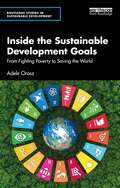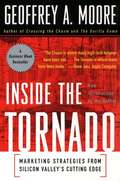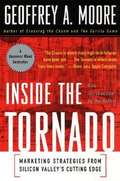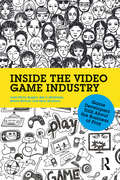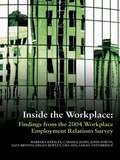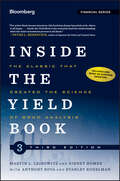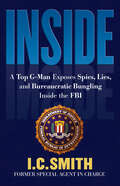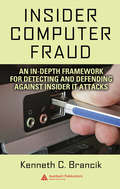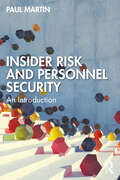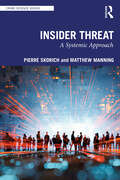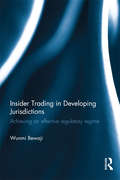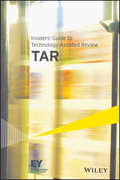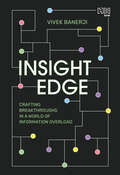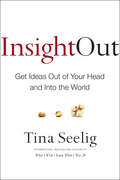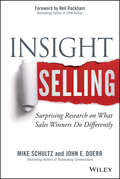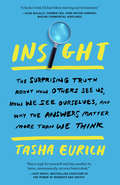- Table View
- List View
Inside the Patent Factory
by Donal O'ConnellThe book is a coaching guide for anyone interested in intellectual property and those wanting to embark on or develop patent creation. It draws on the authors' extensive experience and insights from change projects, management and leadership at Nokia.The book guides the reader through each stage of setting up a successful unit, inviting active involvement by asking vital questions about their needs and aims. Focusing on key issues and themes involved, it provides examples, diagrams and models to illustrate how they can be out in to practice. Critical chapters include the core activities of patent creation, possible organisational models, costs, quality and the comparison of external and internal allocation of tasks. Discussion concentrates on how to such define roles and responsibilities and the management techniques of external resources.The book encourages the reader to challenge their current organisational structure and strategy by introducing various methods and tactics that can be deployed when considering patent creation, then offering advice into the pros and cons of techniques and how such methods can be assessed. The book highlights how knowledge and innovation can be utilised and protected, which due to the increased importance of intellectual property rights, especially the use of patents, is essential for every business.
Inside the Sustainable Development Goals: From Fighting Poverty to Saving the World (Routledge Studies in Sustainable Development)
by Adele OroszThe Sustainable Development Goals (SDGs) came with bold promises: ending poverty, saving the planet, and making this world a better place by 2030. But being in the second halftime, there is too little progress and too many setbacks. Drawing on the expertise of an author who has been actively involved in negotiating and later implementing the SDGs, this book offers a unique insider view into the behind-the-scenes processes. It relates the SDGs and their aims of fighting poverty and achieving sustainability to the bigger picture of politics, economics, and vested interests, breaking down dependencies and alliances, expectations and motives. It uncovers and dissects the politics and interests that shaped the SDGs from the very beginning, as well as the drivers behind propelling or curtailing sustainable development.This book is an indispensable and comprehensive guide to the SDGs. It outlines where they came from, how they are being implemented, the main lessons learned so far, and what to conclude for the years ahead. As the deadline of 2030 is close, and discussions about what should come after the SDGs are imminent, this book is among the first to draw conclusions for the post-2030 era, what to expect, and what to demand from a potential successor agenda.This book addresses policymakers, practitioners, researchers, and students alike, as well as anyone interested in poverty, environment, and sustainability. Written in a highly accessible style, this book also breaks down the United Nations and its processes and institutions, how they are enabling but also limiting the SDGs and the sustainability agenda in general.
Inside the Tornado
by Geoffrey A. MooreIn this, the second of Geoff Moore's classic three-part marketing series, Moore provides highly useful guidelines for moving products beyond early adopters and into the lucrative mainstream market. Updated for the HarperBusiness Essentials series with a new author's note. Once a product "crosses the chasm" it is faced with the "tornado," a make or break time period where mainstream customers determine whether the product takes off or falls flat. In Inside the Tornado, Moore details various marketing strategies that will teach marketers how reach these customers and how to take advantage of living inside the tornado in order to reap the benefits of mainstream adoption.
Inside the Tornado: Strategies for Developing, Leveraging, and Surviving Hypergrowth Markets
by Geoffrey A. MooreGeoffrey A. Moore delves into the high-stakes world of hypergrowth markets. Here, Moore examines these markets and their implications for business strategies and, in turn, provides effective guidelines for winning market share and building margin share in mainstream markets. Once a product reaches the mainstream market, it faces three often vexing questions: What is the best way to develop a stronger market for the product's growth? What is the most effective way to capitalize on and sustain growth? And when this market inevitably subsides, how can businesses survive the change? Moore deftly answers these questions and provides businesses with the knowledge and tools they need in this fast-paced lucrative market.
Inside the Tornado: Strategies for Developing, Leveraging, and Surviving Hypergrowth Markets
by Geoffrey A. MooreIn this, the second of Geoff Moore's classic three-part marketing series, Moore provides highly useful guidelines for moving products beyond early adopters and into the lucrative mainstream market. Updated for the HarperBusiness Essentials series with a new author's note.Once a product "crosses the chasm" it is faced with the "tornado," a make or break time period where mainstream customers determine whether the product takes off or falls flat. In Inside the Tornado, Moore details various marketing strategies that will teach marketers how reach these customers and how to take advantage of living inside the tornado in order to reap the benefits of mainstream adoption.
Inside the Video Game Industry: Game Developers Talk About the Business of Play
by Judd Ruggill Ken McAllister Randy Nichols Ryan KaufmanInside the Video Game Industry offers a provocative look into one of today's most dynamic and creative businesses. Through in-depth structured interviews, industry professionals discuss their roles, providing invaluable insight into game programming, art, animation, design, production, quality assurance, audio and business professions. From hiring and firing conventions, attitudes about gender disparity, goals for work-life balance, and a span of legal, psychological, and communal intellectual property protection mechanisms, the book's combination of accessible industry talk and incisive thematic overviews is ideal for anyone interested in games as a global industry, a site of cultural study, or a prospective career path. Designed for researchers, educators, and students, this book provides a critical perspective on an often opaque business and its highly mobile workforce. Additional teaching materials, including activities and study questions, can be found at https://www.routledge.com/9780415828284.
Inside the Workplace: Findings from the 2004 Workplace Employment Relations Survey (Urn 05/1057 Ser.)
by Alex Bryson John Forth Barbara Kersley Carmen Alpin Sarah Oxenbridge Helen Bewley Gill DixBased on the primary analysis of the 2004 Workplace Employment Relations Survey (WERS 2004), this is the fifth book in the series which began in 1980, and which is considered to be one of the most authoritative sources of information on employment relations in Great Britain. Interviews were conducted with managers and employee representatives in over 3,000 workplaces, and over 20,000 employees returned a self-completion questionnaire. This survey links the views from these three parties, providing a truly integrated picture of employment relations. This book provides a descriptive mapping of employment relations, examining the principal features of the structures, practices and outcomes of workplace employment relations. The reader can explore differences according to the characteristics of the workplace and organization, including workplace size, industrial sector and ownership. Current debates are examined in detail, including an assessment of the impact of the Labour Government's programme of employment relations reform. A key reference from a respected and important institution, this book is a valuable 'sourcebook' for students, academics and practitioners in the fields of employee relations, human resource management, organizational behaviour and sociology. Visit the Companion website at http://cw.routledge.com/textbooks/0415378133/
Inside the Yield Book
by Martin L. Leibowitz Anthony Bova Sidney Homer Stanley KogelmanA completely updated edition of the guide to modern bond analysisFirst published in 1972, Inside the Yield Book revolutionized the fixed-income industry and forever altered the way investors looked at bonds. Over forty years later, it remains a standard primer and reference among market professionals. Generations of practitioners, investors, and students have relied on its lucid explanations, and readers needing to delve more deeply have found its explication of key mathematical relationships to be unmatched in clarity and ease of application.This edition updates the widely respected classic with new material from Martin L. Leibowitz. Along the way, it skillfully explains and makes sense of essential mathematical relationships that are basic to an understanding of bonds, annuities, and loans--in fact, any securities or investments that involve compound interest and the determination of present value for future cash flows. The book also includes a new foreword.Contains information that is more instructive, important, and useful than ever for mastering the crucial concepts of time, value, and returnCombines the clear fixed-income insights found in the original edition with completely new knowledge to help you navigate today's dynamic marketIncludes over one hundred pages of new material on the role of bonds within the total portfolioIn an era of calculators and computers, some of the important underlying principles covered here are not always grasped thoroughly by market participants. Investors, traders, and analysts who want to sharpen their ability to recall and apply these fundamentals will find Inside the Yield Book the perfect resource.
Inside: A Top G-Man Exposes Spies, Lies, and Bureaucratic Bungling Inside the FBI
by I. C. SmithFrom a twenty-five-year career that spanned four continents, an FBI special agent gives you the inside story of the Bureau’s greatest takedowns and biggest screwups.From China to the South Pacific, from East Berlin to Arkansas, I.C. Smith is one of the FBI’s most storied figures. This intrepid G-man has seen it all.In this riveting book about the Bureau, Smith brings a fresh, insider’s perspective on the FBI’s most well-known triumphs and failures of the past three decades. Robert Hannsen. Morris and Eva Childs. Larry Wu-Tai Chin. Aldrich Ames. Smith offers unique insights into how these monumental investigations were handled, or often mishandled, in alarming detail. He also confronts head-on the string of errors inside the FBI—in management and in the field—that directly led to the attacks of September 11th.Filled with startling new information, including more than seventy never-before-published findings, Smith tracks his incredible rise from street agent in St. Louis to special agent in charge of Arkansas—where he took on the corrupt political system that produced President Bill Clinton.
InsideSales.com (A)
by Frank V. CespedesThis case focuses on growth requirements for a company moving from its base in SMB customers (Small and Mid-Sized businesses) to Enterprise customers (companies with more than 500 employees). It examines the differences in buying processes, product requirements, after-sale services, and the implications for organizing and deploying sales resources at InsideSales.com.
Insider Computer Fraud: An In-depth Framework for Detecting and Defending against Insider IT Attacks
by Kenneth BrancikAn organization‘s employees are often more intimate with its computer system than anyone else. Many also have access to sensitive information regarding the company and its customers. This makes employees prime candidates for sabotaging a system if they become disgruntled or for selling privileged information if they become greedy. Insider Comput
Insider Risk and Personnel Security: An introduction
by Paul MartinThis textbook analyses the origins and effects of insider risk, using multiple real-life case histories to illustrate the principles, and explains how to protect organisations against the risk. Some of the most problematic risks confronting businesses and organisations of all types stem from the actions of insiders – individuals who betray trust by behaving in potentially harmful ways. Insiders cause material damage to their employers and society, and psychological harm to the colleagues and friends they betray. Even so, many organisations do not have a systematic understanding of the nature and origins of insider risk, and relatively few have a coherent and effective system of protective security measures to defend themselves against that risk. This book describes the environmental and psychological factors that predispose some individuals to become harmful insiders, and the most common pathways by which this happens. It considers how aspects of insider risk have been altered by shifts in society, including our increasing reliance on technology and changes in working patterns. The second half of the book sets out a practical systems-based approach to personnel security – the system of defensive measures used to protect against insider risk. It draws on the best available knowledge from industry and academic research, behavioural science, and practitioner experience to explain how to make personnel security effective at managing the risk while enabling the conduct of business. This book will be essential reading for students of risk management, security, resilience, cyber security, behavioural science, HR, leadership, and business studies, and of great interest to security practitioners.
Insider Threat: A Systemic Approach (Crime Science Series)
by Matthew Manning Pierre SkorichEstablishing a new framework for understanding insider risk by focusing on systems of organisation within large enterprises, including public, private, and not-for-profit sectors, this book analyses practices to better assess, prevent, detect, and respond to insider risk and protect assets and public good.Analysing case studies from around the world, the book includes real-world insider threat scenarios to illustrate the outlined framework in the application, as well as to assist accountable entities within organisations to implement the changes required to embed the framework into normal business practices. Based on information, data, applied research, and empirical study undertaken over ten years, across a broad range of government departments and agencies in various countries, the framework presented provides a more accurate and systemic method for identifying insider risk, as well as enhanced and cost-effective approaches to investing in prevention, detection, and response controls and measuring the impact of controls on risk management and financial or other loss.Insider Threat: A Systemic Approach will be of great interest to scholars and students studying white-collar crime, criminal law, public policy and criminology, transnational crime, national security, financial management, international business, and risk management.
Insider Trading in Developing Jurisdictions: Achieving an effective regulatory regime
by Wunmi BewajiThe book examines the regulation of insider dealing in the developed jurisdictions, using three of the G7 countries as guides with the aim of knowing how they have regulated insider trading and what lessons can be learnt from their failures and achievements. It looks at regulatory regimes in the US, the UK and Japan in order to consider whether these regimes can be successfully transplanted to developing countries. In order to explore insider dealing in the developing world the book focuses on Nigeria, Africa’s most populous nation and second largest economy. This book examines in theoretical and empirical terms the law on insider trading away from the dogmatic approach of Western literature by presenting the subject from the prism of a developing jurisdiction in post-colonial Africa with a divergent cultural, historical, social, political and economic background. The author analyses what shape insider dealing takes in Nigeria, a predominantly illiterate society, and considers the groups involved. The books also explores how the concept of insider dealing regulation is understood amongst parties integral to its administration and enforcement such as lawyers, judges, stockbrokers, and ordinary investors. The legislation governing insider dealing regulation in Nigeria is critically examined to expose its strengths and weaknesses, and to see how foreign provisions and legislation have been incorporated. The book uses Nigerian experiences to consider its implications for other developing nations, arguing that regulatory regimes need to take into account the specific social, political, historical and economic factors of a particular locale rather than importing regulations wholesale from developed jurisdictions.
Insider's Guide To Passing The California Real Estate Exam
by Rockwell Publishing CompanyRockwell's Insider's Guide to Passing the California Real Estate Exam is designed to help you focus your exam preparation on the material that matters. The first steps to becoming a real estate agent in California include taking a required course in real estate principles and passing the salesperson's exam. The real estate principles course presents an overwhelming amount of information, and most students wonder how much of it they must memorize to pass the exam. The Insider's Guide distills the key concepts tested by the state and presents them in a way that facilitates understanding and retention. The Insider's Guide offers: a targeted review of all essential information, an easy to follow outline format, margin notes to emphasize key points, hundreds of sample exam questions, three complete exams that match the format of the state exam, answers and explanations for all questions, and an index that helps you locate specific information quickly. The Insider's Guide also includes a special section on test preparation strategies, filled with useful tips on how to improve your score.
Insiders' Guide to Technology-Assisted Review (TAR)
by Ernst Young LlpUnderstand TAR mechanics, processes, and technologies, as taught by EY experts Insider’s Guide to Technology-Assisted Review provides professionals with a thorough understanding of the process that is becoming increasingly important to the legal industry. With detailed discussion of the methods, technologies, and practices involved in TAR, readers without advanced degrees in linguistics or related technologies will gain a solid knowledge base upon which to evaluate both current practices and the new tools and technology continually hitting the market. Written by the world-renown experts at Ernst & Young’s Technology and Discovery Services, this book provides a valuable resource for professionals seeking a more efficient way to handle the discovery and analysis process. Technology-Assisted Review streamlines the discovery and document review process by essentially “training” a computer to evaluate documents as required. The term “predictive coding” is used in a narrower sense, but both terms have several meanings, and can mean different things to different firms. Insider’s Guide to Technology-Assisted Review cuts through the confusion, differentiating the different types of TAR and explaining the process and mechanics of each. Readers will: Understand the fundamental concepts of technology-assisted review Simplify ediscovery, documentation, and storage of large document sets Learn how TAR tools work, and the resources they require to function Consider the specialized skillset required to fully exploit TAR technology Technology-Assisted Review is here to stay, as the legal industry evolves to take full advantage of the cutting-edge technology becoming more widely available. As TAR becomes standard practice, it’s important for professionals to understand its possibilities and limitations. Insider’s Guide to Technology-Assisted Review provides clear, comprehensive guidance toward this complex topic.
Insidious Workplace Behavior (Applied Psychology Series)
by Jerald GreenbergInsidious Workplace Behavior (IWB) refers to low-level, pervasive acts of deviance directed at individual or organizational targets. Because of its inherently stealthy nature, scientists have paid little attention to IWB, allowing us to know very little about it. With this book, that now is changing. The present volume - the first to showcase this topic - presents original essays by top organizational scientists who share the most current thinking about IWB. Contributors examine, for example, the many forms that IWB takes, focusing on its antecedents, consequences, and moderators. They also highlight ways that organizational leaders can manage and constrain IWB so as to attenuate its adverse effects. And to promote both theory and practice in IWB, contributors also discuss the special problems associated with researching IWB and strategies for overcoming them. Aimed at students, scholars, and practitioners in the organizational sciences - especially industrial-organizational psychology, organizational behavior, and human resource management - this seminal volume promises to inspire research and practice for years to come.
Insight - Quarterly Magazine Issue- 34 Oct-Dec 2024
by Justin PhilipsIt is a General magazine, presents a diverse collection of expert insights, emerging trends, and in-depth analyses on current affairs, technology, business, and culture.
Insight Edge: Crafting Breakthroughs in a World of Information Overload
by Vivek BanerjiAs Artificial Intelligence reshapes industries, one question looms large: Where does human ingenuity fit?Drawing on decades of experience at organizations such as Insight Dojo, McKinsey and PepsiCo, Vivek Banerji reveals how to generate powerful insights that drive transformational success for organizations. He urges us to embrace the dynamic interplay of art and science, imagination and pragmatism, theory and practice - and to draw inspiration from diverse disciplines, whether it is machine learning, design, statistics, psychology, music, art or sports. Insight Edge makes a compelling case that information alone does not create insight. Instead, it is inherently human qualities - curiosity, analytical thinking, creativity and empathy - that shape meaningful strategies and drive breakthrough outcomes. With real-world examples and actionable frameworks, this book equips leaders and professionals - CEOs, marketers, customer insights experts, strategists, non-profit executives, entrepreneurs, and data analysts - to move beyond algorithms and tap into the irreplaceable power of human insight.
Insight Out
by Tina SeeligWhat if there were a clear set of instructions to help you bring your best ideas to life? As with a recipe, you could take a compelling idea and with concrete steps, transform it into something extraordinary.As a professor at Stanford University, Tina Seelig has dedicated her career to teaching the practice of moving from imagination to implementation. In Insight Out, she welcomes you into her classroom and crisply defines the core concepts of imagination, creativity, innovation, and entrepreneurship, presenting an elegant and much-needed model she calls the "Invention Cycle." This new approach enables you to see obstacles as opportunities, inspire others to share your vision, and ultimately bring more ideas to fruition.Filled with surprising research, examples from her Stanford classroom, and stories from around the world--Silicon Valley to San Quentin State Prison, rural Pakistan to the North Pole--Insight Out offers essential and unexpected strategies that will help bring even the slightest flicker of an idea to life. Equally useful for students, educators, entrepreneurs, and would-be innovators in all fields, this is an essential road map for anyone who wants to get ideas out of their head and into the world.
Insight Selling: Surprising Research on What Sales Winners Do Differently
by John E. Doerr Mike Schultz Neil RackhamWhat do winners of major sales do differently than the sellers who almost won, but ultimately came in second place? Mike Schultz and John Doerr, bestselling authors and world-renowned sales experts, set out to find the answer. They studied more than 700 business-to-business purchases made by buyers who represented a total of $3.1 billion in annual purchasing power. When they compared the winners to the second-place finishers, they found surprising results. Not only do sales winners sell differently, they sell radically differently, than the second-place finishers. In recent years, buyers have increasingly seen products and services as replaceable. You might think this would mean that the sale goes to the lowest bidder. Not true! A new breed of seller--the insight seller--is winning the sale with strong prices and margins even in the face of increasing competition and commoditization. In Insight Selling, Schultz and Doerr share the surprising results of their research on what sales winners do differently, and outline exactly what you need to do to transform yourself and your team into insight sellers. They introduce a simple three-level model based on what buyers say tip the scales in favor of the winners: Level 1 "Connect." Winners connect the dots between customer needs and company solutions, while also connecting with buyers as people. Level 2 "Convince." Winners convince buyers that they can achieve maximum return, that the risks are acceptable, and that the seller is the best choice among all options. Level 3 "Collaborate." Winners collaborate with buyers by bringing new ideas to the table, delivering new ideas and insights, and working with buyers as a team. They also found that much of the popular and current advice given to sellers can damage sales results. Insight Selling is both a strategic and tactical guide that will separate the good advice from the bad, and teach you how to put the three levels of selling to work to inspire buyers, influence their agendas, and maximize value. If you want to find yourself and your team in the winner's circle more often, this book is a must-read.
Insight: How Small Gains in Self-Awareness Can Help You Win Big at Work and in Life (Expert Thinking Ser.)
by Tasha EurichThe first definitive book exploring the science of self-awareness, the meta-skill of the 21st century, Insight is a fascinating journey into everyone's favorite topic: themselves. Do you know who you really are? Do you ever wonder how other people really see you? Though we are usually confident that we do, we are wrong more often than we think. And if we could see ourselves through others’ eyes, we might be really surprised. Yet regardless of our line of work or stage of life, success depends on understanding who we are and how we come across. Research shows that self-awareness means better work performance, smarter life choices, deeper, more meaningful relationships, and a more fulfilling career. There’s just one problem: people can be remarkably poor judges of their behavior, performance, and impact on others. And despite the lip service given today to “feedback,” in the business world and beyond, it’s rare to get candid, objective data on what we’re doing well, and where we could stand to improve. Of course, at work and in life, we’ve all come across people with a stunning lack of self-awareness—but how often do we consider whether we might have the same problem? And if we did, how would we even know it?Drawing on her three-year, first-of-its-kind study of people who have dramatically improved their self-awareness, organizational psychologist Tasha Eurich reveals why we don’t know ourselves as well as we think—and what to do about it. Alongside her research, she integrates hundreds of academic studies and her 15 years of work with Fortune 500 clients, challenging conventional “wisdom” to reveal many surprising truths—like why introspection is the enemy of insight, how experience isn’t a bullet train to self-knowledge, and just how far others will go to avoid telling us the truth about ourselves. Readers will learn battle-tested techniques and tools to improve self-awareness and thus their work performance, leadership skills, interpersonal relationships, and more. Insight is a guide surviving and thriving in an unaware world.

